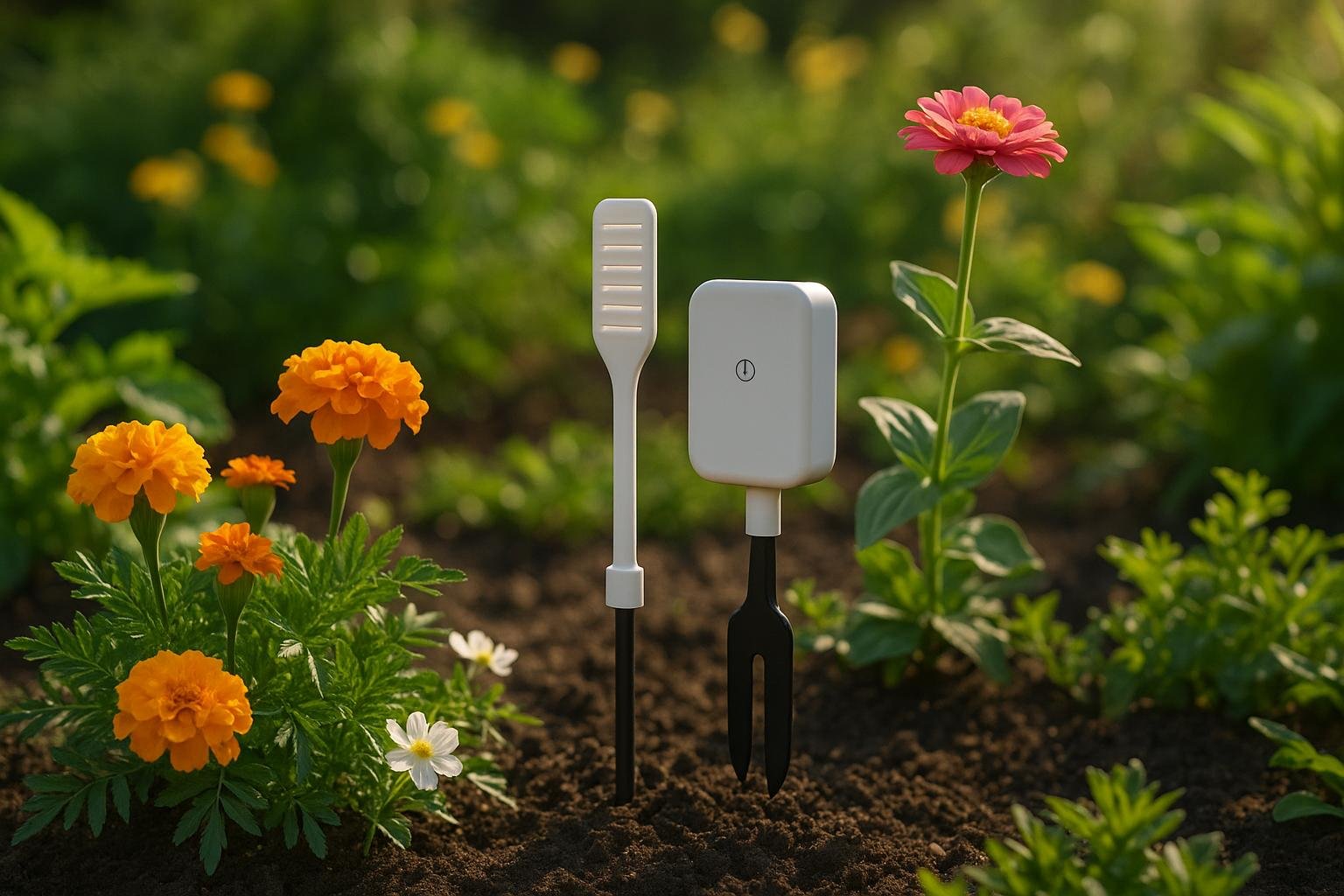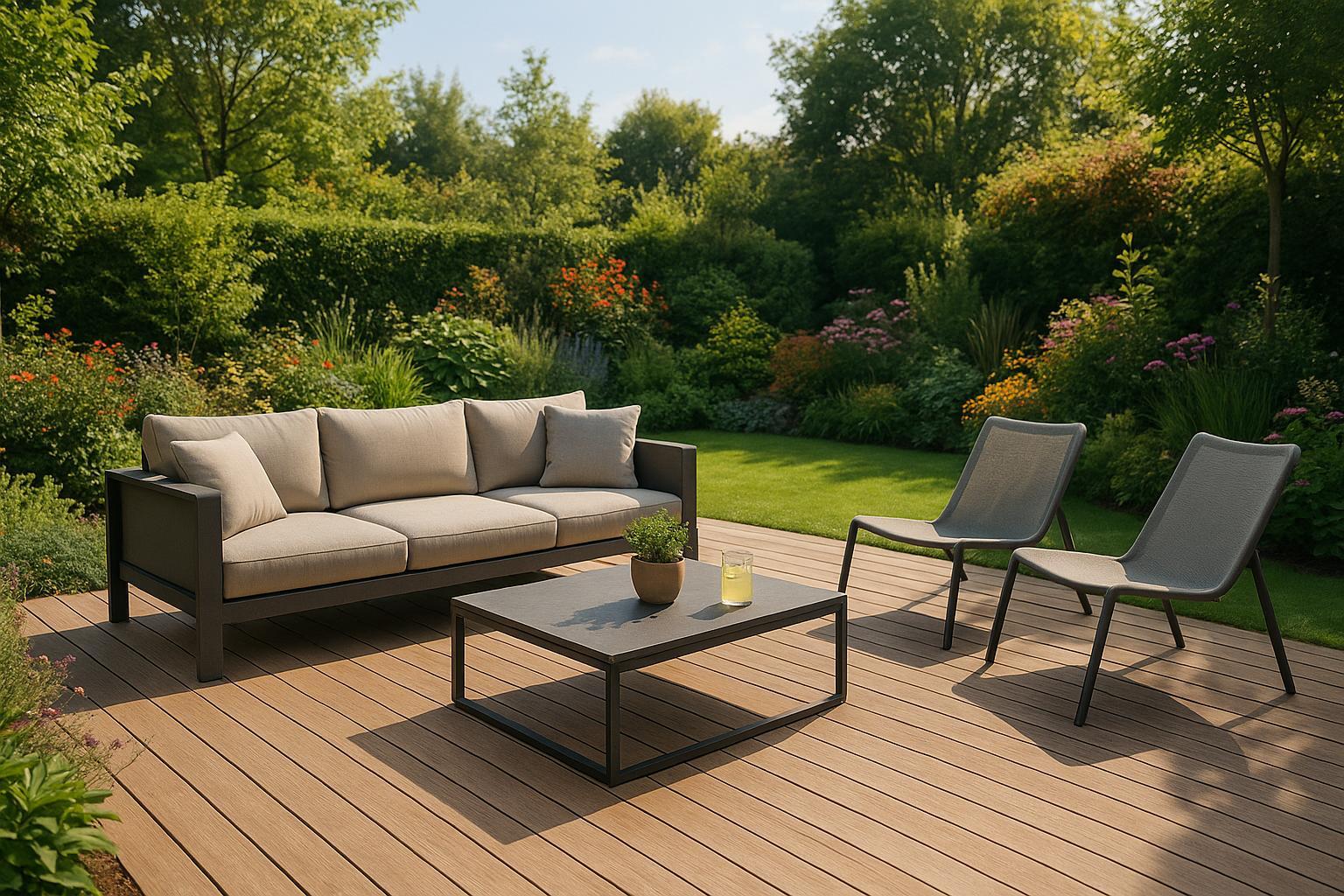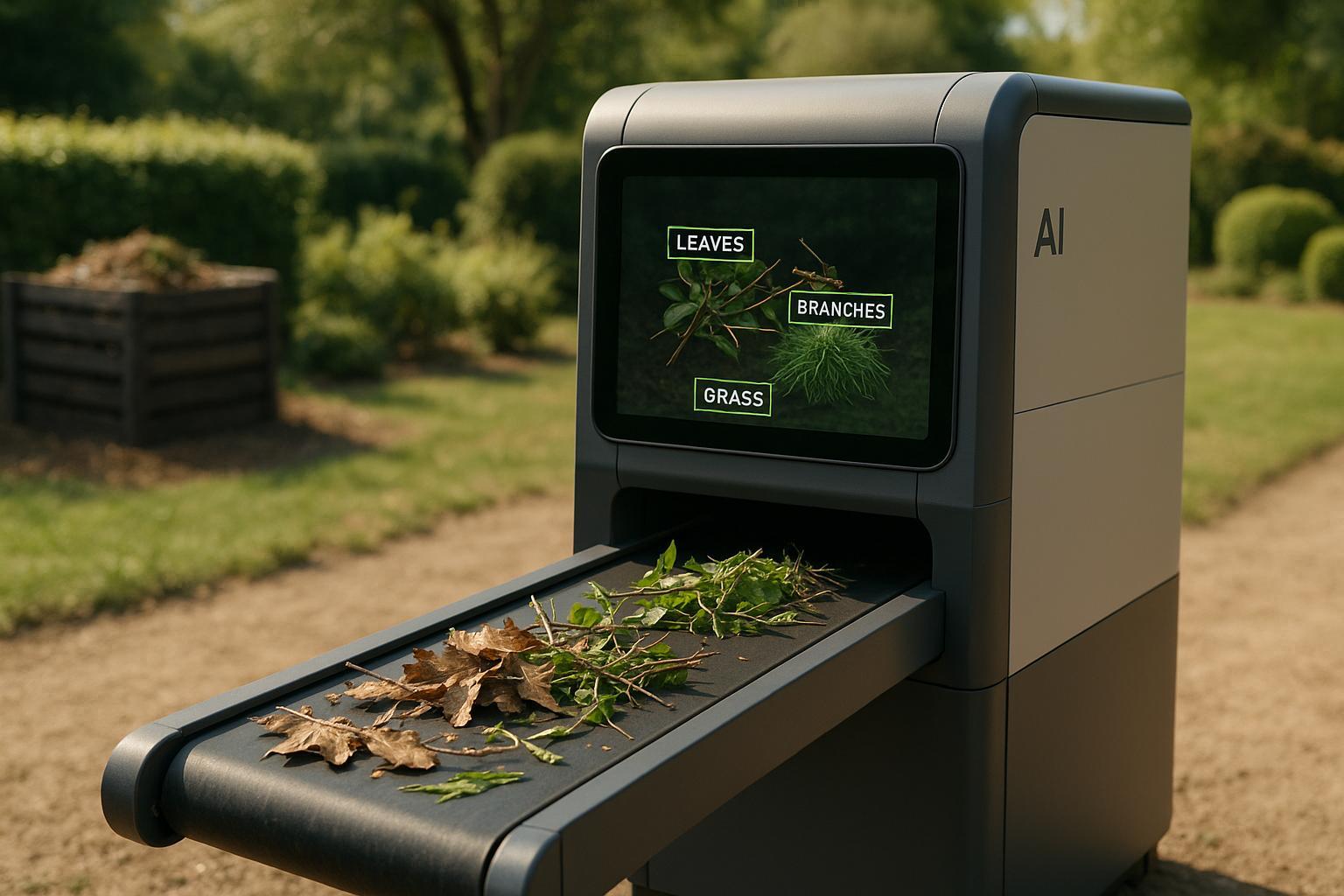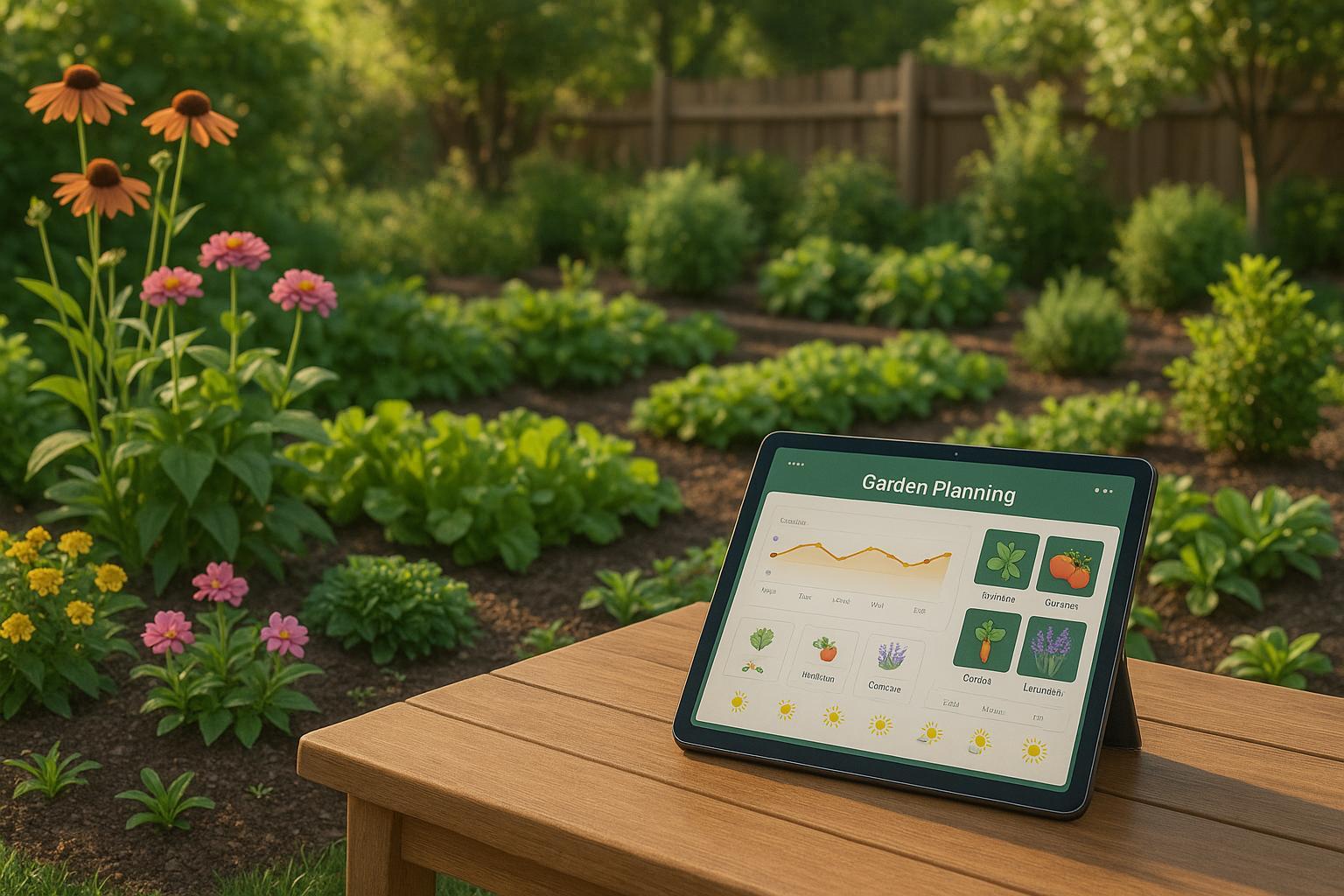Ultimate Guide to IoT Weather Monitoring for Gardens

Gardening is no longer just about intuition. With IoT weather monitoring systems, you can track real-time data like temperature, soil moisture, and light levels to improve plant care. These systems enable better water management, automate irrigation, and even predict pest risks based on weather patterns. Whether you’re maintaining a backyard garden or managing a greenhouse, IoT tools offer precise insights to help your plants thrive.
Key Takeaways:
- Real-time monitoring: Track temperature, humidity, soil moisture, and more.
- Water savings: Adjust irrigation based on live data, cutting water use by up to 30%.
- Automation: Link sensors to smart irrigation for hands-free care.
- Advanced planning: Use AI tools to optimize plant selection and seasonal schedules.
- Hardware essentials: Sensors, solar panels, and data loggers are critical components.
- Software integration: Platforms like ThingSpeak and AWS IoT turn raw data into actionable insights.
IoT weather monitoring doesn’t just simplify gardening - it makes it smarter. From conserving resources to improving plant health, these systems are transforming how we grow.
IoT Based smart garden monitoring system | Smart plant monitoring using Blynk IoT #iot #blynk #esp32

Key Components of IoT Weather Monitoring Systems
Creating an effective IoT weather monitoring system means combining the right hardware and software to work in harmony. Knowing these key elements can help gardeners make smarter choices when setting up their systems.
Hardware: Sensors, Data Loggers, and Power Supply
At the heart of any IoT system are sensors. These devices measure factors like temperature, humidity, light, soil moisture, and pH levels - critical data points for making informed gardening decisions [4][6].
Soil sensors, in particular, are vital. For example, soil moisture sensors with stainless steel probes are durable enough for long-term use, while pH sensors help ensure optimal growing conditions. In greenhouse settings, CO₂ sensors become essential for promoting healthy plant growth [6].
Weather sensors round out the hardware suite. Precipitation sensors, now far more advanced than old-school rain gauges, can measure various forms of precipitation while accounting for wind and temperature changes [5]. Wind speed and direction sensors also provide crucial insights into microclimates and potential stressors for plants.
Reliable power is critical, especially in remote gardens. Solar panels paired with battery backups keep sensors running continuously. Data loggers act as the system's hub, collecting information from multiple sensors and preparing it for transmission to cloud platforms.
A great example of this in action is the Botanical Garden of Rome, which teamed up with Unidata and La Sapienza University to deploy TEKTELIC's KIWI sensors. These sensors track soil moisture, temperature, and light intensity across more than 300 plant species, enabling precise water management and plant health monitoring [4].
Once the hardware is in place, the software layer steps in to turn raw data into actionable insights.
Software: Cloud Platforms and Data Transmission
The software side of IoT weather monitoring systems processes sensor data into meaningful gardening insights. Data collected by sensors is transmitted to central hubs or cloud platforms, where advanced analysis takes place [1]. Using both historical and real-time data, predictive analytics can help gardeners anticipate weather challenges, all accessible through dashboards, mobile apps, or web interfaces [1].
One example is WebbyLab’s 2Smart Standalone platform, which integrates weather data into virtual devices. Their system uses real-time pressure and wind direction data to enhance precision in smart greenhouse operations. Depending on the system’s complexity, data processing can involve advanced models. For instance, deep learning models like LSTM are excellent for short-term weather predictions, while XGBoost algorithms handle long-term forecasting effectively [6].
Integration with Garden Automation Tools
With refined data processing in place, integrating IoT systems with garden automation tools unlocks real-time operational control. Smart irrigation and fertilization systems can adjust water and nutrient delivery automatically based on sensor readings [7][8].
However, challenges like data privacy, security, and connectivity - especially in rural areas - must be addressed [7].
The growing investment in IoT for agriculture reflects its increasing reliability and accessibility. The global agriculture IoT market grew from USD 11.4 billion in 2021 and is expected to reach USD 18.1 billion by 2026. Newer estimates suggest it could grow from USD 16.24 billion in 2024 to nearly USD 40.24 billion by 2034 [7].
For gardeners, tools like AIGardenPlanner can integrate IoT weather data to improve AI-powered design recommendations. By combining real-time environmental conditions with location-specific climate data, these platforms provide more accurate plant suggestions and seasonal planning tailored to a garden's unique microclimate.
Effective integration also requires adopting universal communication protocols to ensure compatibility across devices from different manufacturers [9]. Strong security measures, such as encryption, secure user authentication, and regular firmware updates, are essential to protect sensitive data. Additionally, using edge computing and local AI processing can reduce dependence on cloud infrastructure and minimize data transmission needs [9].
A practical example comes from Cerasus, an agricultural company in Portugal. They use TEKTELIC's CLOVER and KIWI sensors to monitor water usage and environmental data, helping them meet SPRING certification standards for responsible water management. Alexandra Pinto, an agricultural technician at Cerasus, explained:
"Choosing TEKTELIC was a strategic decision grounded in their 15 years of delivering top-tier LoRaWAN® products... their solutions not only boast robustness but also provide the confidence of swift and hassle-free deployment." [4]
Setting Up an IoT Weather Monitoring System
Now that we've covered the essential hardware and software components, it's time to dive into the process of assembling and configuring your IoT weather monitoring system. Careful planning and thoughtful component selection are key to building a system that works seamlessly. Here’s how you can get started, with a focus on gardening setups in the United States.
Planning and Choosing the Right Components
Start by identifying the environmental factors you want to monitor. Common choices include temperature, humidity, soil moisture, and light levels. For specialized setups, like greenhouses or unique crops, you might also want to track pH levels or CO₂ concentration.
When picking sensors, prioritize accuracy and durability. For basic monitoring, the DHT11 sensor is a solid choice for temperature and humidity. If you need more detailed data, consider adding a BMP180 pressure sensor, which captures atmospheric details [10].
Don’t overlook power requirements. Depending on your setup, you might need a steady electrical supply or a solar-powered solution for remote areas.
Sensor placement matters, too. Position soil moisture sensors in representative spots across your garden to get a clear picture of water distribution. Weather sensors, on the other hand, should be placed in open areas with no obstructions to ensure accurate readings.
Lastly, think about connectivity. If your garden is close to your home, Wi-Fi-based systems are convenient. For larger or more remote gardens, LoRaWAN sensors are a better fit due to their extended range.
Configuring IoT Devices and Cloud Platforms
Once you’ve got your components, the next step is connecting everything and setting up communication with the cloud. Arduino boards, especially the Arduino Uno, are a popular choice for weather monitoring projects thanks to their reliability and active user community [10].
Physical connections are straightforward but require attention to detail. For example:
- Connect the DHT11 sensor’s data pin to pin D2 on the Arduino Uno.
- Hook up the BMP180 pressure sensor via I2C (VCC to 3.3V, GND to ground) [10].
To get your system online, use Wi-Fi modules like the ESP8266. These modules allow your Arduino board to connect to your home network and send sensor data to a cloud platform. Writing the code for this setup typically involves the Arduino IDE. You’ll program it to read sensor data and transmit it through your chosen cloud platform’s API.
When choosing a cloud platform, consider your experience level and data needs. ThingSpeak is beginner-friendly and offers easy integration, while AWS IoT and Google Cloud are better for advanced analytics [10]. These platforms not only store your data but also provide tools for analysis, dashboards, and even mobile app interfaces for remote monitoring.
Once your technical setup is complete, it’s time to tailor your system for gardening in the U.S.
U.S.-Specific Considerations
For a system designed to work seamlessly in the United States, a few local adjustments can make all the difference. For instance, configure temperature readings in Fahrenheit and use feet and inches for any distance measurements to align with standard practices.
Think about the climate in your area. If you’re in a hot, arid region, choose sensors that can handle high temperatures. For colder climates, ensure your temperature sensors work reliably in freezing conditions. Similarly, pick humidity sensors that can handle the wide range of moisture levels found across the U.S.
Another important factor is data security. The National Institute of Standards & Technology (NIST) provides advisory standards for IoT devices [11]. Follow best practices, like setting strong passwords and understanding where your data is stored and who can access it.
Lastly, consider internet connectivity in your region. If Wi-Fi coverage is spotty, explore other communication modules like LoRaWAN or cellular options to keep your system running smoothly.
For those using tools like AIGardenPlanner, integrating IoT weather data can take your gardening to the next level. By feeding location-specific microclimate data into the tool, you can get more precise recommendations for seasonal planning and plant selection tailored to your garden’s unique conditions.
🚀 Ready to Reinvent Your Garden?
Join thousands of homeowners who have transformed their gardens using our AI design tool. Upload one photo to explore endless possibilities.
Get your AI garden designs →How IoT Weather Data Improves Garden Performance
IoT weather data is changing the way we approach gardening, offering smarter, real-time insights that help you make better decisions. By continuously tracking environmental factors, these tools allow for healthier plants and more efficient use of resources.
Real-Time Analytics and Actionable Data
With real-time data, you can fine-tune irrigation schedules, cutting down on water waste while giving your plants exactly what they need. By monitoring soil moisture, temperature, and other plant-specific factors, you can water only when necessary. For instance, integrating IoT irrigation systems with weather forecasts allows you to skip watering sessions if rain is on the way, saving both water and effort [12]. This approach is particularly helpful in areas where water conservation is a priority.
There are real-world examples of how this technology is making an impact. In Calgary, a community garden outfitted with TEKTELIC's KIWI Agriculture Sensor and KONA Micro Gateway automated its irrigation process. The system tracked soil moisture, temperature, and electrical conductivity in real time, triggering watering only when moisture levels fell below a set threshold. The results? A 30% drop in water usage compared to the previous year, consistently hydrated crops, and healthier plants across all plots [14].
Another success story comes from a European fruit and vegetable grower who used TEKTELIC KIWI Agriculture Sensors to manage multiple growing zones. The system allowed for more precise irrigation, ensuring consistent soil moisture while addressing the unique needs of each zone [14].
But the benefits go beyond water management. IoT systems can also pick up on early signs of plant stress, diseases, or pest issues by tracking subtle changes in temperature, humidity, and soil conditions. This early detection lets you act quickly, protecting your plants and the time you've invested in them.
To take things even further, AI tools can work alongside IoT systems to predict climate trends and optimize how you allocate resources, making garden management even smarter.
Using AI Tools for Better Garden Planning
AI technology builds on real-time data to improve garden planning and resource management. By analyzing both historical and live data, AI can forecast climate trends and adjust irrigation schedules automatically.
For example, AI-enhanced irrigation systems have been shown to reduce water use by up to 25%, while precision farming techniques powered by AI have boosted crop yields by 20–30% [15]. Smart sensors paired with AI continuously monitor soil moisture and adjust watering schedules to ensure each crop gets the right amount of water, exactly when it’s needed. Over time, these systems learn from past performance and weather patterns, improving their accuracy in resource management.
AI also makes monitoring plant health more advanced. Using computer vision, these systems can analyze data from sensors and even satellite images to spot early signs of diseases, pests, or nutrient deficiencies. This allows you to tackle problems before they escalate [15]. For garden design, AI tools can assess factors like sunlight exposure and soil composition to create layouts that maximize plant growth and health [16].
Platforms like AIGardenPlanner take this a step further by combining real-time, location-specific data with AI-powered recommendations. For example, the platform’s plant advisor can suggest the best varieties for your garden based on your microclimate, using data gathered by your sensors. This ensures that recommendations are tailored to your garden’s actual conditions.
Some advanced systems can process up to 1,000 climate data points per acre every hour [13], delivering an incredibly detailed view of growing conditions. This wealth of information allows AI algorithms to make precise decisions about watering, fertilizing, and other care practices, resulting in healthier, more productive gardens.
"With the right IoT sensors in place, farmers can monitor soil conditions, track livestock, and prevent equipment failures – all in real time. These tools don't just collect data - they deliver clear insights that drive better decisions and stronger results." - TEKTELIC [14]
sbb-itb-4d6a8dd
Maintaining and Troubleshooting IoT Systems
Once you've optimized your garden's performance with IoT data, keeping those systems in top shape is key to long-term reliability. Regular maintenance plays a huge role in ensuring sensors stay accurate and your system remains functional. Since these devices often operate outdoors in conditions like rain, snow, and extreme heat, consistent upkeep - such as cleaning and calibration - is non-negotiable.
Routine Maintenance for Sensors and Hardware
IoT weather sensors are exposed to the elements 24/7, so they require routine care to function properly. At a minimum, inspect your weather station annually, but seasonal checks are even better. As Crodeon advises:
"A weather station should be checked yearly to ensure that all sensors are clean and working. An obstruction could affect your measurements and in the worst case, damage your installation. Parts that are cracked or damaged in other ways, should be replaced." [17]
Here’s how to care for key components:
- Temperature and Humidity Sensors: Clean the protective shields with a cloth to remove dirt, dust, or debris. Clear away nests or residues, and in winter, remove ice or snow to maintain airflow.
- Wind Sensors: Ensure the anemometer spins freely by removing twigs, leaves, or spider webs. Calibrate the wind vane using its North arrow for accurate readings.
- Rain Sensors: Keep the collection funnel free of debris like leaves or insects to avoid distorted precipitation data.
- Solar Panels: Wipe away dust, pollen, or bird droppings that can reduce power output.
- Data Logger Batteries: Replace batteries regularly with the same brand and type. If you notice corrosion on battery holders, clean them gently with a cotton swab dipped in vinegar or lemon juice before inserting new batteries.
- Specialized Sensors: For devices like leaf wetness detectors, applying a UV protectant every 45 days can prevent sun damage. [18]
Protecting IoT Systems from Weather and Tampering
To safeguard your IoT weather monitoring system, focus on both environmental protection and security. Start by choosing a secure installation spot that minimizes exposure to tampering or environmental hazards. This might mean placing sensors in locked enclosures, hidden areas, or elevated positions to strike a balance between data accuracy and security. Avoid locations prone to flooding, extreme temperature swings, or heavy foot traffic.
For added durability, house electronics in weatherproof enclosures rated IP67 or IP68. These enclosures keep out dust and water, even in harsh conditions. Features like vibration-damping mounts and anti-condensation coatings can also protect sensors in high-vibration or humid environments.
To deter tampering, use metal enclosures, security screws, and breakage seals. You can also integrate tamper-detection software that monitors device behavior and sends alerts if something seems off. For instance, during the 2017 Thomas Fire in Southern California, Intellisense Systems' Micro Weather Stations successfully collected critical weather data under extreme conditions, helping firefighters while staying safely out of harm's way. [19]
Once you've secured your system, you’ll be better equipped to handle any troubleshooting challenges.
Troubleshooting Common Issues
Even with regular maintenance, problems can arise. Here’s how to address some of the most frequent issues:
- Connectivity Problems: Weak cellular or Wi-Fi signals, especially in rural areas, can disrupt data transmission. Consider using network boosters or satellite-based solutions to improve connectivity.
- Unusual Sensor Readings: If sensors report odd data, calibration might be the issue. Compare your readings with local weather services or nearby stations. Also, check signal strength and ensure your firmware is up to date.
- False Alerts: Excessive false alarms can lead to data inconsistencies. Machine learning models can help by identifying normal patterns for your garden's environment and adjusting alert thresholds dynamically based on historical and seasonal trends.
- Security and Access Issues: Strengthen security by implementing encryption protocols and robust authentication. Isolating IoT devices on a separate network segment can also prevent breaches from spreading. Regularly audit device configurations, access logs, and monitor for unusual behavior to catch potential issues early.
Pros and Cons of IoT Weather Monitoring
IoT weather monitoring systems bring both advantages and challenges. Weighing these factors can help you determine whether this technology fits your gardening needs and budget. Here's a closer look at the trade-offs to help you decide where IoT weather monitoring might be most effective.
Comparison Table: Pros and Cons
| Advantages | Challenges |
|---|---|
| Real-time data collection allows quick adjustments to changing weather conditions [3] | High upfront costs may deter small-scale gardeners [20] |
| Improved accuracy enhances forecasting and decision-making [3] | Technical expertise required for setup and maintenance [20] |
| Long-term savings compared to traditional weather tools [3] | Connectivity issues in areas with unstable internet [20] |
| Broader sensor coverage enables monitoring across large properties [3] | Data overload can overwhelm users with too much information [20] |
| Early warnings for extreme weather like frost or hail [3] | Sensor calibration challenges – poor-quality sensors may lead to errors [10] |
| Resource efficiency improves water and fertilizer usage [3] | Power supply needs can complicate use in remote areas [10] |
| Automation reduces manual work and saves time [2] | Security and privacy risks with connected devices [20] |
| Eco-friendly benefits through reduced water and energy use [2] | Ongoing maintenance is necessary for accuracy and reliability [22] |
The growing role of IoT in agriculture is clear. The global smart agriculture market is forecasted to triple by 2025, reaching $15.3 billion. Meanwhile, the IoT agriculture market, valued at $13.76 billion in 2022, is projected to grow to $28.56 billion by 2030 [21]. While initial costs can be steep, long-term savings often justify the investment. For instance, some systems have cut water usage by up to 30% by analyzing soil moisture alongside weather data [23].
Technical challenges, though present, are manageable. You can start with basic systems and expand as your budget allows. Open-source options can lower licensing costs [20], and working with vendors experienced in both agriculture and IoT can ease the adoption process.
Best Use Cases for IoT Weather Monitoring
Now that we've outlined the pros and cons, let's explore where IoT weather monitoring works best.
This technology shines in areas where traditional methods fall short. For instance, large gardens or properties with diverse landscapes benefit greatly from multiple sensors that capture detailed data across various microclimates.
Regions with unpredictable weather are another prime candidate. If you're dealing with sudden temperature changes, erratic rainfall, or frequent storms, real-time monitoring can help safeguard your plants and optimize resources during critical periods.
Precision agriculture is another area where IoT excels. Advanced soil sensors, when paired with geospatial data, can create detailed soil maps that guide targeted plant care [21].
Remote or hard-to-reach areas also gain significant advantages. Automated systems provide continuous updates and timely alerts, making it easier to manage zones that are difficult to monitor manually.
Finally, water-conscious gardening is a standout use case. With water conservation becoming increasingly important - and costs on the rise - IoT systems can fine-tune irrigation schedules and volumes based on real-time soil moisture and weather forecasts.
However, for smaller setups like container gardens or herb plots, the costs may outweigh the benefits.
Conclusion: Transforming Gardening with IoT
IoT weather monitoring is reshaping the way gardeners care for their plants, replacing guesswork with precision. By delivering real-time data on temperature, humidity, soil moisture, and other key environmental factors, this technology directly influences plant health and boosts garden productivity [24].
But IoT isn't just about monitoring conditions. Automated systems are taking efficiency to the next level. For instance, research by Lean et al. highlights how a smart farming system powered by Raspberry Pi can automatically adjust watering based on real-time soil data [24]. This not only reduces water waste but also ensures plants get exactly what they need to thrive - resulting in both environmental and financial benefits.
The financial side of IoT in gardening is hard to ignore. With global IoT investments projected to surpass $1 trillion by 2026, environmental monitoring has become a key area of focus [11]. This surge in investment is driving the development of sophisticated tools that are becoming more affordable, making precision gardening an option for everyone.
Remote monitoring is another game-changer. Gardeners can now manage their plots from virtually anywhere using smartphones or computers. Alerts about changing conditions arrive in real time, offering a level of control that would have seemed impossible just a few years ago [25].
Resource optimization is no longer a distant goal - it’s happening now. Take WiseConn's DropControl system, for example. By wirelessly monitoring soil moisture and weather, it helps farmers cut water usage by up to 30% [23]. Home gardeners can adopt similar principles to reduce waste and improve plant health. And with smart AI tools entering the mix, garden management is becoming even more efficient.
Platforms like AIGardenPlanner take this to the next level by combining IoT data with AI-driven insights. These tools analyze current and historical garden data to provide tailored plant recommendations. This blend of real-time monitoring and intelligent planning opens up possibilities for garden optimization that were once out of reach.
The environmental monitoring sector’s growth - from $20.4 billion in 2022 to a projected $38.14 billion by 2031 - signals ongoing advancements and increasing accessibility [11]. This means gardeners at all levels can look forward to even more advanced tools in the years ahead.
IoT-enabled gardening is driving a shift toward sustainable practices that conserve resources while delivering better results. By harnessing real-time data and automation, gardeners can minimize their environmental impact while achieving outcomes that traditional methods simply couldn’t match.
🎨 Visualize Your Dream Garden Today!
Transform any outdoor space into a professional landscape design in minutes. Just upload a photo, choose your style, and let our AI do the rest.
Start your garden transformation now →FAQs
How do IoT weather monitoring systems help save water in gardens?
IoT weather monitoring systems are transforming how gardens are watered by using real-time data to fine-tune irrigation. These systems track factors like soil moisture, temperature, and weather conditions to ensure plants get water only when they truly need it.
By avoiding overwatering and tailoring irrigation schedules to the garden's current state, these systems help cut down on water waste while keeping plants thriving. The result? Less water used and a step toward more eco-friendly gardening practices.
What hardware do I need to set up an IoT weather monitoring system for my garden?
To set up an IoT weather monitoring system for your garden, you’ll need a handful of essential components to get started:
- Sensors: These measure critical factors like temperature, humidity, soil moisture, and rainfall to give you a complete picture of your garden's conditions.
- Microcontroller or data logger: Devices such as Arduino or NodeMCU handle the collection and processing of the sensor data.
- Data transmission module: Wi-Fi or GSM modules are used to send the collected data to your chosen platform for analysis.
- Power supply: You can power your system using batteries, solar panels, or a direct connection to an outlet, depending on your setup's needs.
When combined, these pieces work seamlessly to provide real-time weather updates, empowering you to make informed decisions for your garden.
How do IoT systems work with garden automation tools to enhance plant care?
IoT systems bring a new level of convenience to garden care by using smart sensors to monitor crucial environmental factors such as soil moisture, temperature, humidity, and sunlight levels. These sensors collect real-time data, enabling garden automation tools to make precise adjustments. For instance, they can trigger watering only when the soil is dry or adjust lighting to promote optimal plant growth.
With automated control over tasks like irrigation, nutrient delivery, and climate management, IoT systems create the perfect conditions for plants to thrive. This approach not only boosts plant health but also cuts down on time and resource usage, making gardening easier and more efficient.
Related posts
Related Articles

AI-Driven Garden Furniture Placement: How It Works
Transform your garden with AI-driven furniture placement that optimizes style, comfort, and functionality based on your space and preferences.

How AI Tracks Garden Waste in Real Time
Explore how AI revolutionizes garden waste management through real-time tracking, smart sorting, and enhanced composting techniques.

How Persian Gardens Adapt to Seasonal Changes
Explore how Persian gardens ingeniously adapt to seasonal changes through smart design, plant selection, and water features for year-round beauty.

Mastering Year-Round Garden Design: A Comprehensive Guide
Explore essential tips for creating a vibrant garden all year long, from selecting the right plants to integrating seasonal highlights. Learn how to maintain beauty through every season with our complete guide to year-round garden design.

Modern Garden Styles: Top 8 Trends for 2025
Explore the top 8 garden trends for 2025, blending technology, sustainability, and aesthetics for modern outdoor spaces.

AI Climate Data for Garden Planning
Explore how AI tools transform garden planning with tailored plant recommendations, weather insights, and sustainable designs for thriving ecosystems.